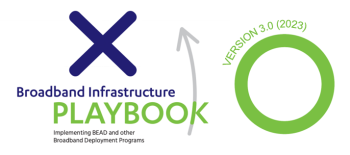I recently had the opportunity to join forces with my friend and colleague, Gary Bolton, CEO of the Fiber Broadband Association, to share some thoughts on the next steps for policymakers in the broadband arena. We took the opportunity to take a snapshot of where the BEAD funding program stands and where it might be going as we move forward and "crunch" time approaches. I'm finding that folks are taking sides on technology choices and I am not surprised at the industry sectors that are fine-tuning their arguments on what is "good enough" for rural Americans, why setting an extremely high-cost threshold is so very important to the future vitality of rural America and why NTCA members should be looking to provide input to their state broadband offices right now. I am simply sharing some of our thoughts we released in a recent blog posting and I welcome any members who would like NTCA's support in working with your state folks to reach out to us.
The Importance of Spending Federal Funds to Build Broadband Right the First Time
Policymakers and stakeholders of all kinds have heralded the Broadband Equity, Access, and Deployment (BEAD) program’s $42.5 Billion in funding as a “once-in-a-generation” opportunity to bring high-performance broadband to all Americans. The key now is to make sure that this generational investment results in generational change.
In the Bipartisan Infrastructure Law creating the BEAD program, Congress established a preference for “priority broadband projects,” defined as projects providing broadband service that meet high performance standards, can scale with consumer and business needs over time, and will enable the deployment of 5G and other advanced services. After receiving input from a wide range of parties, the National Telecommunications and Information Administration (NTIA) determined that “end-to-end fiber optic facilities” were the only platform that satisfied these requirements and warranted such a priority. This is not to say that other technologies cannot and will not receive BEAD funds, but consistent with the calls of Congress, the program aims first and foremost to support fiber-to-the-home deployments to the greatest extent possible.
Now the rubber is meeting the road on all of this. States and Territories are developing the rules (in the form of “initial proposals” to NTIA) that will govern their selection of broadband projects and their distribution of BEAD funds. As part of these initial proposals, subject to NTIA review, States and Territories will establish a “threshold” of project costs at which the fiber priority ceases. (It’s also worth noting that other technologies can win below this threshold as well in areas where no fiber projects are proposed.)
The importance of setting this “extremely high-cost threshold” properly cannot be overstated. We’ve all lived through broadband funding programs that have made the mistake of “incrementalism”— funding lower-performing networks that are outdated soon after or even before they are finished (and well before the funding stops flowing). We cannot afford for the BEAD to repeat these mistakes, leaving unserved residents and communities stranded once more. Again, generational investment demands generational change. But BEAD risks becoming a broadband funding failure if unserved Americans are still standing around in 2030 wondering why taxpayer dollars were used to build networks that might have been marginally acceptable at best in 2023 rather than investing in critical infrastructure for the long-term.
NTCA and the Fiber Broadband Association have therefore called upon NTIA and the States and Territories to make sure that the extremely high-cost threshold is set in a way that matches the vision of Congress to build broadband right the first time. Similarly, it will be important to define the areas for which BEAD funding can be applied in a way that does not undercut the participation of smaller providers or the clearly stated goal of connecting as many as possible to fiber. We’ve offered suggestions and developed a Broadband Infrastructure Playbook and other tools to help in this process, and we look forward to engaging further with these decision-makers over coming weeks and months to get this right. We recognize that this is not an easy process, that there will be different Thresholds, and that there will of course be places that require alternatives to fiber to realize a mission of universal connectivity in the near-term. But NTIA and the States and Territories should aim to “finish the job” when it comes to implementing the clear priority articulated by Congress, which will in turn allow committed providers to “finish the job” by connecting as many Americans as possible to networks that will stand the test of time and give them the opportunity to participate fully in our economy, society, and critical healthcare, educational, and other community institutions.


